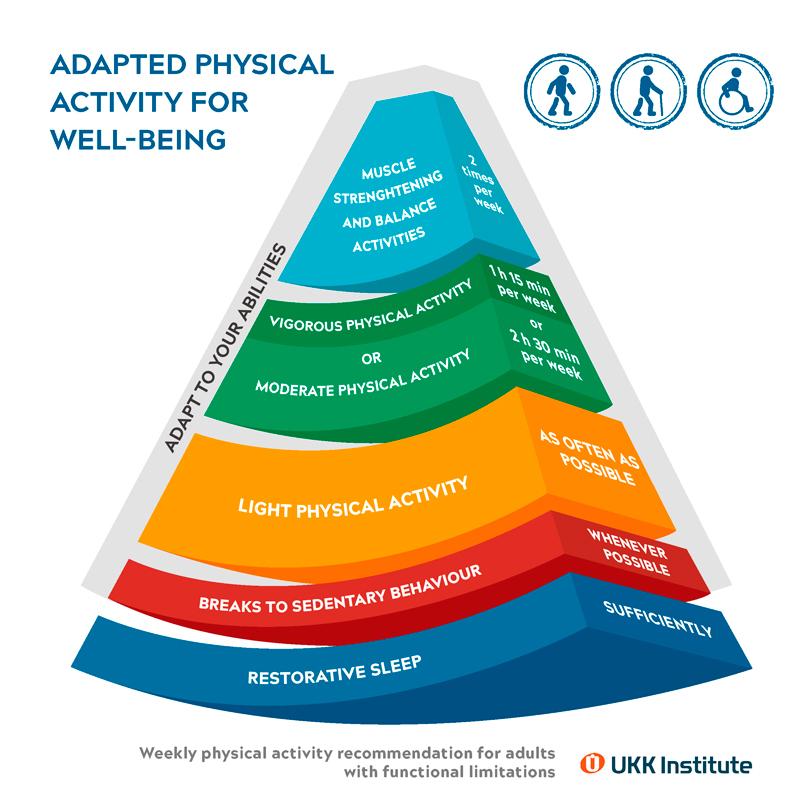Read more about the recommendation on physical activity for adults with functional limitations on this page:
- Content of the recommendation
- Presentation material on the recommendation
- Materials in English
- Background information and instructions for reference
Adapted physical activity for well-being and functional ability
The physical activity recommendation for adults with functional limitations is designed for adults who have functional limitations due to an illness or injury, or who use assistive devices such as a walking stick, a rollator or a wheelchair.
The physical activity recommendation for adults with functional limitations introduces the weekly amount of physical activity essential for functional ability and well-being. It also gives advice on how to increase physical activity in everyday life.
There are altogether three physical activity recommendations for adults with functional limitations: for adults with some functional limitations; for adults walking with an assistive device and for adults using a wheelchair.
Functional ability is shaped individually by physical, mental and social factors. Healthcare and sports professionals can help to find the right form of physical activity or exercise and assistive device for you. These physical activity recommendations have been created for use in physical activity counseling, allowing the healthcare professionals to recognise each client’s individual functional ability.

Physical activity sustains your functional ability in everyday life
Regular physical activity
- prevents, treats and rehabilitates several illnesses
- improves physical fitness
- makes daily tasks easier.
Even short bouts of physical activity are beneficial
The updated recommendation has the same core as before: moderate physical activities that increase your heart rate should be performed for at least 2 hours 30 minutes per week. The same health benefits can be achieved by increasing the intensity of the physical activity from moderate to vigorous, in which case the required minimum duration is 1 hour 15 minutes per week. Muscle strengthening and balance activities should be practised at least twice a week.
The duration requirement for an episode of physical activity used to be a minimum of 10 minutes. This requirement has been revised, and according to the updated recommendation, few minutes of physical activity at a time count, too.
How much physical activity is good for you?
Muscle strengthening and balance activities
at least twice a week
- Train your muscles and challenge your balance. Combine exercise with stretching.
- Choose an appropriate exercise, e.g. gym training, group exercise or dance.
Moderate physical activity
at least 2 hours 30 minutes per week
- Any activity that increases your heart rate counts.
- Modify exercise according to your abilities, e.g. swimming, canoeing or ball games.
Physical activity is moderate if you are able to talk despite shortness of breath.
OR
Vigorous physical activity
at least 1 hour 15 minutes per week
- You can achieve the same health benefits in a shorter time by increasing the intensity of your activity.
- Choose and adjust physical activity according to your abilities, e.g. Nordic walking, cycling or skiing.
Physical activity is vigorous if talking is difficult due to shortness of breath.
Balance physical activity with rest
The updated recommendation on physical activity pays close attention to overall well-being. Light physical activity, breaks to sedentary behaviour and restorative sleep are recognised as an important part of our well-being.
Recent studies suggest that even light physical activity has positive health impacts, especially on people who are physically inactive. Light physical activity can lower blood sugar and lipid levels, improve blood circulation and increase joint and muscular flexibility. It is important to move and create breaks to sedentary behaviour every day – the more, the better.
Light physical activity
as often as possible
- All movement counts: household chores, shopping trips and other daily activities.
- Apply appropriate ways according to your abilities, e.g. yard work, grocery shopping, taking the dog out.
Breaks to sedentary behaviour
whenever possible
- Movement activates your muscles and reduces stiffness and stress on your body. It also improves your well-being and helps maintain your functional ability.
- Apply appropriate ways according to the situation, e.g. take breaks from sedentary behaviour or do stretching exercises.
Another new part in the weekly physical activity recommendation for adults with functional limitations is restorative sleep. Sufficient amount of restorative sleep and physical activity have significant health benefits. Sleep also has an important role in recovering.
Restorative sleep
sufficiently
- Adequate sleep is important. During sleep, the body recovers from the daily stress.
- Listen to your body, take a nap and rest when you feel the need to.
Move daily or almost daily in versatile ways. Adapt physical activity to your health and abilities.
Physical activity creates comprehensive well-being
- Your brain activates.
- Your happiness increases.
- Your stress reduces in the nature.
- You relax and unwind.
- Your mood is boosted.
- You become a part of a group.
Presentation material on the recommendation
Weekly physical activity recommendation for adults with functional limitations. (2020). Presentation in SlideShare:
Materials on the recommendation on physical activity for adults with functional limitations in English
Information materials
- Brochure
- Picture
Materials for group guidance
Materials for individual guidance
Background material
2018 Physical Activity Guidelines Advisory Committee Scientific Report. Washington, DC: U.S. Department of Health and Human Services, 2018.
Instruction for reference
Adapted physical activity for well-being and functional ability. Weekly Physical Activity Recommendation for Adults with Functional Limitations. The UKK Institute for Health Promotion Research, 2020. https://ukkinstituutti.fi/en/products-services/physical-activity-recommendations/weekly-physical-activity-recommendation-for-adults-with-functional-limitations/
Last updated: 15.5.2025
